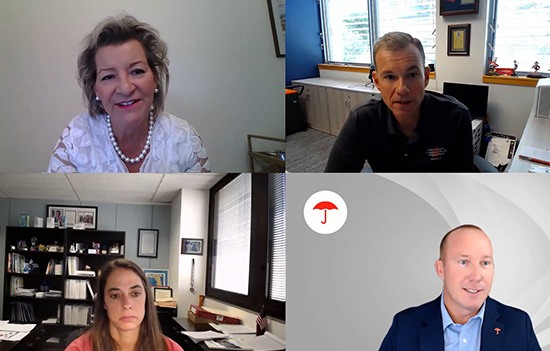Wind, Hail, Rain, Fire: LIVE from IBHS!

Wind, Hail, Rain, Fire: LIVE from IBHS!
July 24, 2024
Wednesday 1:00 p.m.-2:00 p.m. ET
Ever wonder why some buildings better withstand impacts from hail, wind, rain and wildfire? We took viewers on a live, exclusive tour of the Insurance Institute for Business & Home Safety (IBHS) Research Center, a nonprofit state-of-the-art research facility, to see its full-scale test chamber and wall of 105 wind turbines. A walk through IBHS’s hail lab allowed us to learn how it creates realistic hail and shoots it through a cannon to evaluate the performance of common building materials like shingles and siding. We also witnessed a full-scale wildfire demonstration to preview the latest research focused on wind-driven building-to-building fire spread. Watch the replay to learn how IBHS translates science into action to help make communities more resilient and how insurance industry support makes that possible.
Watch webinar replay
[MUSIC PLAYING]
(DESCRIPTION)
Text: Wednesdays with Woodward (registered trademark) Webinar Series. Travelers Institute (registered trademark). Travelers. 15 Years. The Wednesdays with Woodward text appears on the image of a laptop screen, next to a mug with the Travelers umbrella logo. Joan Woodward appears in a video call tile in the upper right labeled, IBHS Test Chamber.
(SPEECH)
JOAN WOODWARD: Hi, there. I'm Joan Woodward, President of the Travelers Institute and Executive Vice President of Travelers Insurance. Welcome to another session of Wednesdays with Woodward, where clearly, I am not in my usual location. We're going to get on with the show, folks. But first, let's look at our disclaimer about today's program.
(DESCRIPTION)
Text: About Travelers Institute (registered trademark) Webinars. The Wednesdays with Woodward (registered trademark) educational webinar series is presented by the Travelers Institute, the public policy division of Travelers. This program is offered for informational and educational purposes only. You should consult with your financial, legal, insurance or other advisors about any practices suggested by this program. Please note that this session is being recorded and may be used as Travelers deems appropriate. The next slide says, Wind, Hail, Rain, Fire: LIVE from IBHS. Logos appear, for Travelers Institute, Travelers, UCONN School of Business M S In Financial Technology, Trusted Choice dot Com, Professional Insurance Agents, MetroHartford Alliance, American Property Casualty Insurance Association, and Risk and Uncertainty Management Center, Darla Moore School of Business, University of South Carolina.
(SPEECH)
I also want to spend a minute thanking our terrific partners, the University of South Carolina School of Business, TrustedChoice.com, the American Property Casualty Insurance Association, the National Association of Professional Insurance Agents, the Master's in FinTech Program at UConn and the MetroHartford Alliance.
Welcome. And thank you for bringing all of your networks to our show today. Again, as you've noticed, I'm not sitting at home in Washington, D.C. Instead, I'm in Richburg, South Carolina, at the Insurance Institute for Business and Home Safety Research Center and Lab. Lots of cool things happening here. This is an independent, nonprofit, state-of-the-art research facility supported by the insurance industry.
(DESCRIPTION)
Fans spin on an industrial wall behind Joan, who shuffles through papers in her hands.
(SPEECH)
And we're going to get a special behind-the-scenes sneak peek of our hail lab, our fire lab, our wind and rain lab, our roofing lab today here at IBHS.
(DESCRIPTION)
The speakers' headshots appear over the names and titles. Text: Speakers: Joan Woodward, Executive Vice President, Public Policy; President, Travelers Institute, Travelers. Roy Wright, President and CEO, Insurance Institute for Business and Home Safety. Anne Cope, PhD, P.E., Chief Engineer, Insurance Institute for Business and Home Safety. Chris Sanders, Research Project Scientist, Insurance Institute for Business and Home Safety. Faraz Hedayati, PhD, Lead Research Engineer, Insurance Institute for Business and Home Safety.
(SPEECH)
We have, over the next hour, many experts, chief scientists, fire, hail experts joining us to discuss their research that's in progress and some of their findings that have been implemented in building codes across the country. So to start us off, I'd like to welcome to the stage IBHS President and CEO Roy Wright.
(DESCRIPTION)
Roy joins Joan in front of the fans.
(SPEECH)
Roy, thank you so much for hosting us today.
ROY WRIGHT: Thank you for coming. We get to spend a Wednesday with Joan Woodward. This is so much fun for us.
JOAN WOODWARD: Well, Roy joined this organization in 2018, about six years ago, from FEMA. He was the head and ran the entire National Flood Insurance Program.
ROY WRIGHT: And I lived to tell about it.
JOAN WOODWARD: And you liked it. OK. He also overstood the Federal Insurance Mitigation Administration and directed resilience programs for earthquake, fire and wind risks at FEMA for many years. So thank you so much for welcoming us to this amazing facility. Our viewers, who may not be so familiar with IBHS, I want to hear about this organization, what its mission is, what the facilities kind of look like. And give them a feel of actually being here.
ROY WRIGHT: Yeah. So IBHS was created in an earlier generation, about 45 years ago. But really, what we see here today has been in motion for about 15 years. After Hurricane Katrina, the property insurance industry came together and built this place and said, we need to understand what Mother Nature does. We need to be able to understand what happens on wind, rain, wildfire and hail. And so we are a 501(c)(3).
We're an independent nonprofit fully funded by the property insurers. What does that mean? We do a whole lot of science. But that science, yes, meets needs inside the insurance industry about how to really narrow the kinds of losses. But maybe more importantly, our mandate from the board is to translate the science so people can put it to use. We want more homes to be survivable. We want the structure to survive.
We want them economically to be able to survive. And so every single week, this room, this kind of cathedral of wind that we have here that you're going to get to experience-- on this very place, “Good Morning America” was here last fall. And everything at full-scale burns, plays out in that space. We do the unique research so that the insurance industry can then help deliver it to people.
JOAN WOODWARD: It's really, really valuable research. And this is one of the largest test facilities in the world that does full scale. You actually furnish a home to see how--
ROY WRIGHT: There is no other facility in North America that does this work.
JOAN WOODWARD: So let's talk about some of the biggest perils. We know wind, fire. Obviously, wildfire in the last several years has been incredible. What are we learning here? And are those perils different than they were, say, 50 years ago?
ROY WRIGHT: I think the way that those perils are affecting people and communities are different. I'll let a scientist walk you through the specifics on how the perils are playing out. But we take wildfire. Frankly, wildfire rarely invaded communities decades ago. But over the last seven to eight years, we've really seen that invasion take place, not only losing a few structures. We're actually seeing that kind of catastrophic work with conflagration.
On wind, we think about hurricanes-- we'll talk about that, but so many severe convective storms. 2024 has had an outlandish number of hail and wind, severe convective storms.
JOAN WOODWARD: What's a convective storm, versus a regular storm, versus a hurricane storm just to make sure everyone's on the same page?
ROY WRIGHT: So hurricanes are those kind of cyclones that come off the coast. The balance of the storms that we experience that produce heavy rain, lightning and hail, a meteorologist refer to those as severe convective storms.
JOAN WOODWARD: OK. So we're going to take a look now at a quick video of something you replayed here in the wind hall and the rain hall. That's what we're seeing first?
ROY WRIGHT: You're going to see this place in action.
JOAN WOODWARD: OK. We'll see you on the other side of the video, folks.
(DESCRIPTION)
Houses lay in ruin, with debris littering the street and backyards. Seals say, IBHS Research Center Wind and IBHS Research Center Rain.
(SPEECH)
REPORTER: Wind is responsible for billions of dollars in losses each year, from tornadoes and hurricanes to straight line winds.
(DESCRIPTION)
A tornado spins over a grassy area. In the lab, wind rips off the roof of a house. From outside the lab building, A tall, curved wall is lined with large fans.
(SPEECH)
IBHS is the only lab in the world that can test full-scale buildings in highly realistic windstorms using a wall of 105 fans to produce wind speeds of up to 130 miles per hour.
(DESCRIPTION)
In the lab, a house disintegrates. From inside a lab, house furniture whips around. A house crumbles. The lab-made wind rips shingles from a roof.
(SPEECH)
Using this technology, we test common roof coverings like asphalt shingles to reveal their weaknesses during high winds, garage doors to highlight their role in keeping the wind out of a home, and we analyze wind-driven rain and how water intrusion into a home becomes a damage amplifier.
(DESCRIPTION)
A garage door buckles in from the outside. Water pours through ceiling light sockets. Ceiling insulation drips with water.
(SPEECH)
Research in our test chamber has informed our FORTIFIED home standard, demonstrating the importance of keeping the roof on, roof deck sealed to keep water out, and even how to reinforce your whole home against the forces of winds.
(DESCRIPTION)
Lab homes slide and crumble. A piece of wood shoots into the window of a house. An entire roof and attic lifts away.
(SPEECH)
Our goal in all of this is to inform the insurance and construction industries on how to mitigate common vulnerabilities, communicate weaknesses in products and test standards to manufacturers, and to empower homeowners with the information they need to withstand the hazards of severe weather.
[MUSIC PLAYING]
(DESCRIPTION)
The roof blows outside through the back of the lab. A fire burns. A man aims a lit device at a test structure. Logo: Insurance Institute for Business and Home Safety (registered trademark). Joan now stands next to Anne Cope at a station of roofing samples.
(SPEECH)
JOAN WOODWARD: OK. Wow. I feel like I'm blowing in the wind there after that video. Joining me now is the Chief Engineer of IBHS, Anne Cope. You've been here many decades looking at all of these perils. First of all, tell us what we saw in that video. And then we want to talk about roofing materials.
ANNE COPE: Absolutely. So the video put together some of the great shots of this facility in action, showing exactly what can happen when Mother Nature is doing her thing and sadly tearing up the built environment. What we have here in front of us is an opportunity for you to get hands on with the features that are highlighted in that video about how do we keep roofs more resilient, how do we keep them on and keep the water out of your house.
JOAN WOODWARD: OK. I'm ready. Let's do it. Let's take a look.
ANNE COPE: So what we've got here is this is the part that is underneath the roofing. So you drive by. You look at your typical house. You see the asphalt shingles on top. This is the stuff that's underneath.
(DESCRIPTION)
Anne touches a sheet of charcoal-colored material with green dots spaced around on its surface. The face of the station underneath the samples reads, 1. Nail it Down. Keep the Roof On. 2. Seal it Up. Keep the Water Out. 3. Lock it In. Keep the Wind Out. Three steps to keep wind and water out. Logo: Fortified Roof.
(SPEECH)
And there are three key pieces to the FORTIFIED roof. And they're right here on the front of the thing. You got to make sure that the roof is nailed down to keep it on. You got to make sure that it's sealed up. You want the rain to stay out of your room and not on your couch.
And third, you’re going to lock in the bottom of the roof. And we're going to describe right now exactly why that's so important. So in terms of the locking it down and sealing it up, that's what we've got here. On the left closest to you is a very typical roofing construction. You've got your thin felt paper stapled down. So a roofer will come and just bang, bang, bang, staple that down to keep it on long enough to get the shingles on.
(DESCRIPTION)
Joan flips up a corner of the material nearest her, a thin, dark gray sheet stapled to the wooden surface below.
(SPEECH)
What I've got on my side is the FORTIFIED roof. And so this is a thicker felt paper. And you can see all of these green circles. So this is a button cap. That circle, it's just a little small plastic circle. But what it does is an amazing job of allowing that nail to bite down into this and keep this on.
(DESCRIPTION)
Anne touches the material nearest her, gesturing to the green dots.
(SPEECH)
So we're going to get Hurricane Joan.
JOAN WOODWARD: OK.
ANNE COPE: All right. And actually, you don't even need a full hurricane. Shingles have been shown to be vulnerable in tropical storm winds, in severe convective storm, thunderstorm winds. So you decide, Hurricane or Tropical Storm Joan.
JOAN WOODWARD: OK.
ANNE COPE: I want you to just peel up on this and see how quickly it comes off.
JOAN WOODWARD: Oh, gosh.
ANNE COPE: Here we go.
JOAN WOODWARD: Here we go. 1, 2, 3. Go. Whoa.
(DESCRIPTION)
Joan rips up the less-durable material, almost completely removing it from the wood surface below.
(SPEECH)
ANNE COPE: It's super easy, right?
JOAN WOODWARD: I can do that.
ANNE COPE: I know. This is terrible. So here's the point to take away from this is this piece here is the same as we just slapped some paper on our roof. So let's just go ahead and take that thing all the way off. Boom. All the way off. And it's gone.
(DESCRIPTION)
Joan finishes removing the material and sets it to the side.
(SPEECH)
Now on this side, this is going to cause us a little bit more action, which is the whole point, right? So let's see how much it takes to pull this one off, all right?
(DESCRIPTION)
Joan tries to get her fingers under the more-durable material and looks up at Anne when she can't.
(SPEECH)
It is amazing how much these little green button caps add to the resistance of this roof. And that's OK. Between the two of us, we're going to get this thing off.
JOAN WOODWARD: I don't think I could do this.
ANNE COPE: And the whole point being that it's hard to get off. There we go. What we want to do is expose--
JOAN WOODWARD: OK, I'm exhausted.
ANNE COPE: Exactly. Well, isn't that wonderful? That's the whole point.
(DESCRIPTION)
Joan and Anne manage to rip off sections of the material between rows of green caps. Anne rips a strip through the center.
(SPEECH)
We want to expose the middle so that we can show you the difference here.
JOAN WOODWARD: I might need some help, fellas.
ANNE COPE: Yeah.
JOAN WOODWARD: I'm just saying.
ANNE COPE: That's all right. That's the exactly the whole point.
JOAN WOODWARD: OK.
(DESCRIPTION)
Joan continues ripping up small sections.
(SPEECH)
ANNE COPE: This is good enough. What we've got here is we have exposed the difference between the one on the left, the very typical construction, and the one on the right that is showing you the difference. This is the sealed roof deck.
(DESCRIPTION)
On the newly-exposed wooden surface below, a black piece of flashing tape across the center says, ZIP system Flashing Tape.
(SPEECH)
If you take a look at that typical one, there is a big gap.
(DESCRIPTION)
On the other sample, two wood pieces meet at an exposed seam.
(SPEECH)
So first of all, people usually say, well yeah. Exactly. Anne, why is there a big gap between the pieces of wood? What's going on there?
Your home actually looks underneath a bit like a kitchen colander. It is supposed to have those gaps because that allows the wood to expand and contract because if it were right up against each other, it would-- when it gets too warm and too wet, the wood would go like this, and our houses would look terrible.
(DESCRIPTION)
Anne butts her hands together and tents her fingers.
(SPEECH)
So you have to have the amount there to allow the wood to expand and contract, but we want to protect that opening. Shingles are vulnerable.
The stuff that's underneath the shingles in typical construction is vulnerable. We want to keep the rain out. So we have come through and done our tropical storm best. And now we're going to see what happens when we get the rain out. So you've got rain, and I've got rain.
JOAN WOODWARD: OK.
ANNE COPE: And we're going to pour it here.
(DESCRIPTION)
Anne pours a bottle of water over the side with flashing tape. Joan pours her water over the side with the wide seam. Each wooden surface is slanted at an angle.
(SPEECH)
And on my side, the rain is going straight down into the gutter.
(DESCRIPTION)
From underneath Joan's side, water drips straight down through the exposed seam.
(SPEECH)
JOAN WOODWARD: OK. And my side is not?
ANNE COPE: And your side is not. Let's do one more bottle here. And you can really see the difference.
(DESCRIPTION)
Joan and Anne each pour another bottle over their respective sides.
(SPEECH)
And we're just pouring two water bottles worth of rain here. In a typical event, you could get much more water than that. Most of the rain on your side has gone through that hole just like it would in a kitchen colander. And it's down into the attic.
(DESCRIPTION)
From the underside of Joan's material, water continues dripping through the gap.
(SPEECH)
For every 1 inch of rain that your meteorologist is talking about falls on your house, if you have a typical 2,000-square-foot house open like that one, nine bathtubs worth of water is coming through and soaking your attic.
Your ceiling is going to fall down on your couch, just like what happened for my parents back in the 2004 storm season. So this is a very inexpensive thing to do to really mitigate damage. And we'll come over here and take a look. This is the piece. This is what it looks like when it's properly put together.
(DESCRIPTION)
Joan and Anne walk to another station that shows the layers of a fortified roof, with flashing covering a seam between two wood pieces and gray material overtop, secured with red button caps.
(SPEECH)
This is what it means to tape the seams and have that FORTIFIED sealed roof deck.
JOAN WOODWARD: So here's the seam we're taping, right?
ANNE COPE: That is exactly it. This is the gap which has to be there. And we're going to use a tape. And there's a couple of different tapes that you can use. We're going to use a tape to cover the seams. We're going to make sure that the underlayment has the button caps. We're going to make sure that the shingles have a proper starter strip.
(DESCRIPTION)
Anne gestures to the edges of the gray material. She then gestures to a bracket-like piece, hugging the bottom edge of the wooden material.
(SPEECH)
And we're going to make sure that the edge detail is great and buttoned down and using this drip edge.
Those pieces together make a beautifully resilient roof. You can reduce damage by, like, a multiple of four when you roof the right way. And this is information that Travelers agents can get right on our website and show people how they should be talking to their roofer.
JOAN WOODWARD: OK. So when someone has hail damage or a roof damage that is an insurable loss, the agent really should tell them to go on the IBHS website and understand fully because roofing contractors don't necessarily talk about this, right? What percentage of roofing contractors in the country today would explain all this to someone in a way that IBHS would agree with?
ANNE COPE: Well, in the state of Florida, this is in the code. And so I love to see that when we're starting to get this into the code. Along the hurricane coastline, there are jurisdictions that are starting to adopt the pieces of code where this is, like on the coast of Carolina, but not everywhere and certainly not in Hail Alley. We want roofers to embrace this. We're working with NRCA and others. It's getting there. And agents and homeowners can be part of the push to get this type of stuff out there.
JOAN WOODWARD: OK, so asking-- if you're a customer out there or if you're an agent, talking about this when they're filing a claim for any reason is critical. That moment of if you're going to do-- and how much more expensive is this for a 2,000-square-foot house or a 3,000-square-foot? How much more expensive versus the typical?
ANNE COPE: Absolutely. The difference here is in some materials. And so the cost can be as low as $500 per house for the different materials. When roofers are not familiar with it, there's an additional cost of I don't know what you're talking about. We're watching that come down as people are getting more and more familiar with it. Alabama, coastal Carolina, we got plenty of roofers doing the right thing.
JOAN WOODWARD: Anne, thank you so much for being with us. Anne is going to join us at the end of the show. But now we're going over to the hail lab, which is a lot cooler, I think, than this room. The hail lab. We're going to watch a short video right now. So we'll see you on the other side of the video, folks.
(DESCRIPTION)
A seal reads, IBHS Research Center Hail. Dark skies hang over a road across the plains.
(SPEECH)
REPORTER: From Nebraska and Iowa down to Oklahoma, Kansas and Texas, this year's IBHS hail field deployment crisscrossed the Great Plains in search of hail-producing thunderstorms.
(DESCRIPTION)
Researchers stand outside white cans with the IBHS Research Center Hail seal. Text: Ian Giammanco, PHD, Lead Research Meteorologist. Ian sits inside a research van.
(SPEECH)
IAN GIAMMANCO: Ten observation days out of about 15 in the field, that's a record for us.
REPORTER: Each day of the trip starts with an assessment of the day's forecast, where a storm target area is identified.
(DESCRIPTION)
Ian uses a laptop and phone inside a vehicle as clouds roll across the sky.
(SPEECH)
IAN GIAMMANCO: I also think we'll probably see initiation down the dry line.
REPORTER: Teams get into position and wait. Then as the storm approaches, the instrument deployment begins.
(DESCRIPTION)
Ian runs with a white instrument on a stand. Text: Lucas Faulkner, Lab Technician. Lucas sits in a van.
(SPEECH)
LUCAS FAULKNER: That's a high-stress, intense moment, too, because you're jumping out of the van. You usually, as safe as you can, pulled off on the side of the road.
REPORTER: Each deployment consists of three teams, one that deploys an array of disdrometers and two teams that focus on shingle panel drops.
BRENNA MEISENZAHL: The panel teams, we can be pretty quick and pretty aggressive when it comes to storms because it's not going to take us that long to deploy what we need to deploy and move out of there.
(DESCRIPTION)
Grasses whip around in wind as Ian and another researcher position an instrument. Text: Brenna Meisenzahl, Research Project Scientist. Brenna sits in front of a cart in the van.
(SPEECH)
REPORTER: After the instruments are deployed, teams retreat to safety, returning to retrieve the instruments and panels after the storm has passed.
JAKE SORBER: We take those panels back to the lab, assess the damage on them, compare them with the kinetic energy that we got on the disdrometers, and see if we can correlate kinetic energy flux to damage severity.
(DESCRIPTION)
A van pulls away as it rains. After the storm, Ian rushes to retrieve the white instrument. Text: Jake Sorber, Research Project Scientist. Jake stands to the side of the road.
(SPEECH)
REPORTER: Teams also collect and measure the hailstones in order to validate the instrument observations and perform a compressive strength test, crushing the hailstone to measure the amount of force needed to fracture it.
MAN: Ready to crush. Crushing.
(DESCRIPTION)
Using a vice-like instrument, a researcher crushes a hailstone between two white plates.
(SPEECH)
REPORTER: Each storm the teams encounter in the field is different, some producing larger hailstones that will provide valuable information on which materials perform best in severe hail events and how many hailstorms the materials can survive, while others produce smaller stones in larger amounts.
(DESCRIPTION)
Green grass pokes through a blanket of hail on the ground.
(SPEECH)
IAN GIAMMANCO: Also captured is one of my favorites, which is high concentration hail that covered the road in northwest Kansas.
REPORTER: This year, teams also had a chance to analyze some giant stones in order to catalog the structure of the ice.
IAN GIAMMANCO: We were able to go 3D scan those in the hotel. We also took some cross sections of those hailstones to look at the internal ice structure.
(DESCRIPTION)
A researcher handles a baseball-sized hailstone with a crystalline structure. Cross sections of a large stone show concentric rings and jagged outer edges. Hail pummels one of the white instruments during a storm.
(SPEECH)
REPORTER: All of the data collected on the trip is taken back to the IBHS Research Center, where it's pooled with data from previous trips to continue expanding knowledge on hailstorms.
BRENNA MEISENZAHL: It's a really cool experience to be able to actually see what you are trying to reproduce in the lab and seeing it in real life.
REPORTER: It's also used to help validate lab data on shingle products that have been tested at IBHS.
(DESCRIPTION)
A roof sample sits outside. Researchers run to their van. Hail crashes down.
(SPEECH)
And finally, IBHS will now be able to use the data to simulate real-world hail events inside the small hail lab and the test chamber during full-scale testing.
IAN GIAMMANCO: Everything we know about a hail event, its strength, the sizes, the concentrations, and actually run a material, a building material through that exact case as best we can.
[MUSIC PLAYING]
(DESCRIPTION)
A fire burns. A man aims a lit device at a test structure. Logo: Insurance Institute for Business and Home Safety (registered trademark). Joan stands with Chris at a lab table with a boxy instrument on it. Behind them, windows enclose an area with roof samples.
(SPEECH)
JOAN WOODWARD: So welcome to the IBHS hail lab. I'm standing with Chris Sanders, who is the head researcher on hail here. But after they do that kind of testing-- and look, I am holding an actual-- well, it's a 3D replica of it. But a hailstone was found to be this big in South Dakota. Look how big it is compared to my hand. And there's a few other we're going to talk about here today.
(DESCRIPTION)
Joan holds up the gray replica, which is about as big as her hand.
(SPEECH)
But after the research is done, they bring it back here to this hail lab. And Chris, what goes on here? And tell us what we're going to be working on today.
CHRIS SANDERS: Yeah. So here at our lab, as you can see behind us, we've got our hail bays, where we're actually going to be shooting stones and conducting some of that research.
JOAN WOODWARD: You're going to let me shoot a hailstone, right?
CHRIS SANDERS: Absolutely. It's probably one of the more fun things I think you'll do today. But absolutely, we're going to shoot a hailstone. So if we actually want to maybe talk about these a little bit, you pointed out the Vivian, South Dakota, one. But we also have the Alabama state record. And this guy is actually printed to weight. And you can kind of feel that. You can feel how much heavier it is than the--
JOAN WOODWARD: That's very heavy.
CHRIS SANDERS: Right.
JOAN WOODWARD: Yeah. OK. This is in Alabama?
CHRIS SANDERS: Yeah. Yeah. Yeah.
JOAN WOODWARD: Is it usually jagged like this?
CHRIS SANDERS: Yeah. So typically, the larger ones are going to have more of a amorphous nodular.
JOAN WOODWARD: The larger ones?
CHRIS SANDERS: The smaller ones haven't quite had the time to develop those yet, but the larger ones usually are going to have protrusions coming off of them.
(DESCRIPTION)
Joan sets down the red Alabama stone model, flat with numerous nodules.
(SPEECH)
JOAN WOODWARD: So what is the current test standards for hail? And how maybe is IBHS doing things differently than other people who are testing for hail?
CHRIS SANDERS: Yeah, that's a great question. In the standardized testing arena, the hail impact standard that is typically used is UL 2218. And that's a steel ball drop. And I'll give this to you again. This one is deceptively heavy. So whenever you pick it, you can really feel how heavy it is.
JOAN WOODWARD: Definitely heavy.
(DESCRIPTION)
Joan raises and lowers her hand with the metal ball inside.
(SPEECH)
CHRIS SANDERS: Now, that particular test does get the kinetic energy right that it's impacting with, but it does two impacts in the same location. And just the impact mechanics of steel and ice, very different from each other.
JOAN WOODWARD: And how fast is a normal hailstone kind of coming down to hit your roof at impact? What is that about? Give us a sense.
CHRIS SANDERS: Yeah. So it's one of those things that it's really stone dependent. It kind of depends on the size of the stone and then also the weight of the stone. But basically, they're all going to reach terminal velocity. And so they'll be falling at different speeds based on the different size of the stone. But really, what we want to do here in our lab is replicate the kinetic energy that we measured in the field back with our cannons here. So that's the big kicker.
JOAN WOODWARD: Are we ready?
CHRIS SANDERS: Yeah, we are. We are. Absolutely.
JOAN WOODWARD: So tell me how you make your ice. So there's some ice in here, you said.
CHRIS SANDERS: Yeah, so there's ice here. And we use these big blue machines behind us to actually create those stones.
(DESCRIPTION)
Chris and Joan walk to a white chest freezer.
(SPEECH)
So let's pop some of these guys out. So the spherical ones here are actually made off of the machines. The machines-- but you also notice we have these kind of realistic stones.
(DESCRIPTION)
Chris hands Joan a couple round ice stones from cartons inside the freezer. One stone is opaque white while the other is mostly clear.
(SPEECH)
This is kind of early stages of where we're going to go into with some of the research. It's not the easiest thing to do to reproduce hundreds of stones just like this.
We have these nice automated machines that will make round ones. But it uses a heated former that won't work with the spiky stones. So we'll actually pass this over to Michelle. And we'll walk through the process that she would normally take.
JOAN WOODWARD: I just got one out of the freezer. And then you measure it?
CHRIS SANDERS: Yeah. So we're going to take two measurements here. We're going to take the weight of the stone. And then she's also going to take the diameter of the stone and enter that into the computer. And then from there, she's going to walk around, load us up, get us ready to go, and then let you fire it off.
JOAN WOODWARD: OK. I'm ready. Good.
(DESCRIPTION)
Michelle stands at a computer with Joan's synthetic stone.
(SPEECH)
CHRIS SANDERS: So this one weighs 61.5 grams.
JOAN WOODWARD: OK. That's typical for a kind of a smaller hail test?
CHRIS SANDERS: Yeah. So the average hailstone-- or the average 2-inch hailstone is going to be around 60 grams. There's a little bit of plus/minus that we allow for in there. Obviously, there's some tolerances in the real world. And so we keep it within 15% of that. So yes, it was within the bounds of what we would want for weight.
(DESCRIPTION)
Michelle walks behind the windowed partition to load the stone into a machine.
(SPEECH)
And it looks like we're getting set up and ready to fire.
JOAN WOODWARD: And this is my trigger?
CHRIS SANDERS: This is your safety trigger at the same time.
JOAN WOODWARD: --this is less than I did on pulling up-- I had to pull shingles off that roof. That was kind of hard.
CHRIS SANDERS: That can be really tough. But we're ready to go. All right. So Joan, what you're going to do is you're going to arm, push and hold. And then with your other hand, you're going to hit fire.
JOAN WOODWARD: OK. Ready.
(DESCRIPTION)
Joan holds down one button on the boxy device, then presses another. The hailstone shoots out and hits a roof sample.
(SPEECH)
OK. That was good.
CHRIS SANDERS: Yeah, so that particular stone came out. I was reading the radar gun there at 64 miles an hour, 64 miles an hour. Now, again, that's not necessarily the fall speed of those stones in the real world. But what we're trying to mimic here is actually the kinetic energy. So now that we've impacted it, let's walk over and take a look.
JOAN WOODWARD: Wonderful. Great.
(DESCRIPTION)
Chris and Joan walk behind the partition and up to the roof sample. In the top left corner, a shingle is indented from Joan's stone.
(SPEECH)
CHRIS SANDERS: We'll kind of slide our cannon out of the way, so we have a little more room. But if you actually-- if you want to run your finger over this spot right here, you can actually kind of feel that divot a little bit in there. And so what we do from here is we'll actually measure that dent and ridge, the granular loss that occurs, and then also go through and actually score the tears on there as well.
JOAN WOODWARD: And what type of asphalt roof? Because most people have asphalt roofs, right?
CHRIS SANDERS: Yeah, so 75% of the homes in the United States have asphalt shingles on them. Brand name-wise, I'm not sure exactly which brand this is. But this is an architectural impact-resistant shingle, so it is supposed to be designed to withstand that type of hail impact.
JOAN WOODWARD: OK. And you have a rating system that has been really helping the roofing industry. And contractors kind of upgrade to what you think is a better material.
CHRIS SANDERS: Yeah. So over when we first launched this program, we had one particular manufacturer that had a poor rating on their product. And because of our influence and because of what we were doing, they ended up buying all of that product back off of the market, and taking it off the market completely, and then reformulating and coming at it again.
JOAN WOODWARD: Wow. So obviously, not a lot of us have a new roof on our house. So you have an aged asphalt shingle farm. You have a different outside-- when we were walking around, you have a 10-year, or five-year, a 20-year. So you're aging these shingles and then testing again.
CHRIS SANDERS: Yeah. Absolutely. One of the big concerns, whether it's wind, hail or fire, is what is the age process due to these materials? Because it's all fine and dandy when you put it on your house on day one. But what does that look like five years down the line, 10 years down the line?
JOAN WOODWARD: So you've really positively impacted how the manufacturers think about their shingles. And if a homeowner went on your website, do you have a recommended-- I know you're not recommending different-- but the product itself, not the brand.
CHRIS SANDERS: So we do have some consumer information out there for anybody who wants to go out and really pick the best of the best. So you can actually go to ibhs.org and get on our website. We have our public ratings that we put out for impact-resistant shingles. We do that every two years, so it's constantly being redone. The last one was done last year. And then the next one coming will be in 2025.
JOAN WOODWARD: OK. Wonderful. So then we're moving over here, I think, to look at-- what are we looking here.
CHRIS SANDERS: Yeah. So this is just another impacted shingle.
(DESCRIPTION)
Chris and Joan walk to a roof sample with different areas of the shingles circled.
(SPEECH)
And really, I just want to point out we've got some different colored circles on here. And it's not just because we like different colors-- or just coloring things. They actually mean something. They are impacted areas. So each one of these has been impacted within that circle. But the different colors of the circles actually mean different things.
So the blue here represents what we call a hard bounce. And the green represents a hard shatter. And that's kind of the harder, more strong stones that we impact with because there is a range of that internal strength.
JOAN WOODWARD: So explain the difference between what the actual hail coming at the building is and then what the damage is. I mean, is there different hail storms that produce different kinds of hail that we want, prefer, or kinds that we don't want?
CHRIS SANDERS: So it's really kind of a mixed bag. It can kind of depend on that particular storm and its dependence. But there will be hard and soft within that storm. And so we capture that statistically within our impact test protocol for asphalt shingles. And to the question you're asking, what's the difference between the blue and the green there, I've said they're both hard stones. But the blue is what we call a hard bounce. And so what that means is whenever those stones impact, they impact and still stay together. And they just bounce off.
JOAN WOODWARD: Bounce off? Is that what you want? You want that or not really?
CHRIS SANDERS: It's not necessarily I want it or I don't want it. It's more of that it's a specific type of damage that occurs with the hard bounce as opposed to a hard shatter, where that impact kind of shatters and shrapnel goes everywhere. So it's a difference in the damage mode between those two. And then the soft stones, which is the orange ones, do it even differently.
They are more like a snowball if you were to throw it at your buddy and it just sticks. And what it does is it sticks and then shears granulars off in a different direction than the other two. And so with our impact test protocol, we try to capture all of that because all of that can occur in the real world.
JOAN WOODWARD: Wow. OK. Who knew there were all these different types of hails, different types of testing going on here? It's been amazing. I wish everyone was standing here with me able to shoot some hail. It was very fun. Next up, we're going to go to wildfire. So we're going to play a video for you. A few weeks ago here at IBHS, they ran a wildfire test on a completely furnished ADU. If you're not familiar with those, these are big in California-- accessory dwelling units.
And a lot of people have them in the back of their houses. Some people have a cottage house, maybe. So it's a small, self-contained house, got fully furnished with a kitchen, and bathrooms, and so forth. So you did this burn a few weeks ago. We're going to see the results of that. And we're going to talk to the chief wildfire expert here at IBHS. So take a look at the video.
(DESCRIPTION)
The front of a lab house burns, with water spraying on it from the front.
(SPEECH)
REPORTER: When a fire grows from a spark to conflagration, wildfires transform into disaster, spreading through our built environment, wreaking havoc on suburban landscapes.
(DESCRIPTION)
Fire roars through a wooden fence.
(SPEECH)
Adapting to this hazard requires finding ways to prevent the ignition of structures to break the chain of fire, and in turn, bend down the risk curve.
(DESCRIPTION)
A shed smolders. People in firefighting gear douse the flames on the lab house.
(SPEECH)
That's where IBHS research comes in, showing us how fire propagates, informing us on the characteristics of embers and how they attack homes and how fires use connective fuels to spread through communities.
(DESCRIPTION)
Pipes spray glowing embers at a lab house. Fire rips along two wide strips of material on the ground. Lab sheds burn.
(SPEECH)
This research has identified vulnerabilities, like decks, combustible fences and vegetation within the first five feet surrounding a home and has introduced ways to mitigate such risks.
(DESCRIPTION)
Embers fly around a tattered fence. Black smoke billows from a shed outside the lab.
(SPEECH)
Wind-driven, building-to-building fire spread, which examines the critical role of structure spacing.
Insights from this initiative underscore how densely packed communities can facilitate conflagration once fires spread into areas where the wildland and urban environments meet.
(DESCRIPTION)
Remains of burned houses line a snowy neighborhood road. Flames curl around a lab house.
(SPEECH)
IBHS is continuing to expand its capabilities, now focusing on material performance and combustion thresholds, all in an effort to help communities become more resilient on the pathway to coexisting with wildfire.
[MUSIC PLAYING]
(DESCRIPTION)
Flames blow back off of a snowflake-shaped structure. Logo: Insurance Institute for Business and Home Safety (registered trademark). I B H S dot-org. Roy sits with Anne outside. Behind them, people in protective gear walk around sample houses.
(SPEECH)
ROY WRIGHT: Good afternoon. And welcome to the IBHS Research Center. You are joining us directly in progress. My name is Roy Wright. I get to help lead the IBHS organization. I'm sitting here along with Anne Cope, our Chief Engineer. And you're about to walk alongside us as we take on this next phase of wildfire research. This wind-driven spread of fire is something we've been looking at from sheds and outbuildings.
Today, we make a big leap towards accessory dwelling units. You'll hear us call it as ADUs in this space. And so what is being modeled for us today is that embers have reached this ADU. And this ADU has a window that's been compromised. And so embers have gotten inside.
(DESCRIPTION)
Footage shows different areas of the A D U, which has furniture, a toilet, a ceiling fan, and other effects inside.
(SPEECH)
One of the first things we're going to be able to see is that ember is going to ignite a couch.
ANNE COPE: Yes. So this ADU has been outfitted with all of the regular furniture and things like that that would see. It's Christmas time inside this ADU, so there is a Christmas tree there in the house. And embers will absolutely come inside an open window or a vent into the attic space that would allow embers in. Something catches. And that small spot fire will then convectively light other things within the room.
ROY WRIGHT: And so as we look at this, we'll talk a bit about-- we always want to see things that are realistic. In the past, we've looked at what might be out in a shed. But as the viewers can see, you're looking inside a 625-square-foot home that should look like someone's home.
ANNE COPE: Absolutely. This has got all of the stuff in it. You're going to see the couch. You're going to see the tables. You're going to see cushions, pillows, stuff on the couch, all of which burn. All of these things burn. So if you look closely at the footage, you can see a small flame right now dancing on that couch.
(DESCRIPTION)
A small couch burns in the A D U living space.
(SPEECH)
That's how small it is when these things start. That ember is really little.
And that little spot fire is going to translate into something terrible. You can see, boom, it's gotten to the Christmas tree now. That small fire that was at the couch has now transitioned to the Christmas tree. Because it's in that corner, things are going to happen very quickly there. It's right there. It has nowhere else to go, except but to consume all the fuel that's right there.
ROY WRIGHT: And so we're seeing the temperature inside the structure continue to move up.
(DESCRIPTION)
Flames consume the tree beside the couch and reach up the corner toward the ceiling.
(SPEECH)
ANNE COPE: Yes, we're talking about temperatures in excess of 900 degrees Fahrenheit. This is more than anything your conventional oven has thought about.
(DESCRIPTION)
Shower glass begins to darken, as does the corner of another room.
(SPEECH)
We're talking about double what your oven is doing. In some of the camera shots, you can see things that look like Igloo coolers. That is actually has cold water in it to circulate for instruments that measure heat. We're measuring heat flux. And we're measuring temperature.
So we can take that information, and we can say, OK, when a typical structure is burning, what's happening inside there?
(DESCRIPTION)
Wires connect to an orange cooler beneath a window inside the structure.
(SPEECH)
It's the same idea as the aircraft that fly in the middle of the hurricanes. What's going on in the eye of the storm? What are the temperatures? What is the heat flux? And then on the target building, when something like a typical ADU is burning, what is happening to the buildings that are just 10, 20, 30 feet away? We're measuring that here with this experiment.
ROY WRIGHT: So this experiment is looking at 30 feet of distance. So why 30 feet?
ANNE COPE: Well, so 30 feet in previous examples is somewhere where we thought, oh, yeah, we can see through the science at 30 feet when you have a shed that's burning full of wooden cribs with a high load. At that distance, the impact to the target building where we're measuring heat flux is low.
(DESCRIPTION)
A larger dwelling sits spaced apart from the A D U. Smoke wafts toward it.
(SPEECH)
And that seems to be a safe distance. We've also tried 10. Not safe distance. At 20 feet, it really depends on what you are burning, what the impact is to the target structure.
So some of the features that it has, it has a one-hour fire-rated wall. The siding on the house is actually combustible, but the wall assembly, the other pieces that are part of the wall, create a one-hour fire wall.
(DESCRIPTION)
A tall instrument stands between the A D U and main dwelling.
(SPEECH)
It has-- this particular one has open-eaves vents, very typical of California construction. And that's one thing that we're testing here to see how vulnerable those are. The building also has really good windows. They are dual pane and tempered glass, but the vulnerability might be the frame.
ROY WRIGHT: So we rejoin this piece. There's been a reignition that has happened inside that living room. And we're watching something that happens. Once you can get it hot enough from that fire, we see the spillover happen.
(DESCRIPTION)
Flames pour from a window on the A D U.
(SPEECH)
ANNE COPE: Absolutely. So we have moved from spread not just the contents of the building, but now we've got the skeleton of the building itself is consuming-- you can hear the difference. You can hear the crackling. You can hear that there are pieces of that structure, the roof, the walls that are being consumed.
ROY WRIGHT: You're watching the color of the smoke fundamentally change. And this is what's different. When we did some of the other tests, as we looked at with sheds and the like, we used primarily wood as the fuel. In this case, we have household appliances, so kitchen.
(DESCRIPTION)
Black smoke plumes from the A D U windows and doors.
(SPEECH)
ANNE COPE: Right. The kitchen is going to have all the normal things in it, the cabinetry, the table, the flooring. All of those are normal pieces in there.
ROY WRIGHT: There's a washer. There's a dryer. There's a hot water heater, a whole series of things that can withstand a lot until they can't.
ANNE COPE: Until they can't. It is really just billowing out of the windows. That is wind-induced behavior. So when we have wildfire conditions, we often have significant wind speeds. And as that wind is pushing the fire, you see it exiting the structure and extending those flames. So most of the things that we're looking at in terms of how do we adapt and mitigate against wildland fire impacts to our neighborhoods are all-- it's not about the if.
It's about the when things are happening. When embers come, how do we protect against them?
(DESCRIPTION)
Charred walls lead up to the now nonexistent roof of the A D U. Wind bends the flames toward the main house.
(SPEECH)
One of the reasons why we're doing so many different variations of ADUs is that we're going to take all of those measurements and then apply that to the science of protecting communities, not just individual homes.
ROY WRIGHT: We thank you for joining us. This is a project we are doing in collaboration with Cal Fire. They, too, are interested and have made investments in this research to understand how fire performs. IBHS has been partnering with Cal Fire to get these pieces. This is a multi-phase, multi-year test series.
(DESCRIPTION)
The A D U smolders behind Roy and Anne.
(SPEECH)
Soon, you'll be sifting through data.
ANNE COPE: Oh, there's a ton of data here. And we're going to capture that. It's going to tell us a lot about the next time we burn. And it's really going to tell us about the density and connected fuels between our structures in our neighborhoods.
ROY WRIGHT: Some of you are going to get to watch this go all the way to ash. Thank you. Thank you for joining us today.
(DESCRIPTION)
A fire burns. A man aims a lit device at a test structure. Logo: Insurance Institute for Business and Home Safety (registered trademark). Joan stands next to a glowing black chamber with Faraz. The chamber is glossy black with a tube extending from the back. It glows orange through a window inside and sits on a wheeled stand.
(SPEECH)
JOAN WOODWARD: Wow. Well, that was quite the video. I'm back in the large chamber now with Faraz Hedayati. He is the head of fire research here, wind and fire research. And we have a little ember generator here just to give you a sense of what else they use to try to brush fires and other things in this chamber. So Faraz, talk to me about what we just saw, all the research that led up to it. What were you testing for? What products were you looking out for? What did you expect? What was different than what you expected in the outcome?
FARAZ HEDAYATI: So when we looked at-- when we traveled to Paradise after the 2018 fire, Camp Fire, we realized that the structure separation has a big influence on the cascade of damage in the community. And then when we went to Santa Rosa after the Glass Fire or more recently to Lahaina, we keep seeing that the structural separation has a big role. So back in 2018, we started working with FSRI to look at this. And we burned down a few homes.
JOAN WOODWARD: What is FSRI?
FARAZ HEDAYATI: Fire Safety Research Institute.
JOAN WOODWARD: OK.
FARAZ HEDAYATI: Yeah. So we burned down a few homes in Ohio to look at how fire spread at the no-wind condition. And then we came to the lab because of the facility that we have here. We expose the same structures, different sizes to wind. And then the last test that you saw was the first test in the new test campaign that we are working with Cal Fire, UC Berkeley, University of Maryland to analyze and understand how fire jumps from one building to the other as a function of building material, to your point, wind speed and a structure separation.
JOAN WOODWARD: OK. You’ve also done a lot of research on shrubbery and mulch, like ornamental things that people love to have so lushly around their houses. But what are you finding? I mean, we talk a lot about just getting rid of all this in especially fire susceptible places and putting in concrete. People, do they want that or--
FARAZ HEDAYATI: Well, I think there is-- I understand the resistance because it's not like the traditional definition of visually appealing backyard, basically. But it plays a big role because the zero to 5 foot around buildings is the area that embers accumulate. And if we have any combustible in that area, fire can grow vertically. And then that fire can touch the building cladding. And that's not what we want to see. That would pose the structure to very intense heat level that can consume the building rapidly. And then that would lead to structure-to-structure fire spread.
JOAN WOODWARD: OK. And talk to us about what IBHS does with different states and their building codes because we know the building code incentive, the contractors must follow that when there is a fire, or a new build, or a rebuild of something that's been damaged. So what are you doing with the codes?
FARAZ HEDAYATI: So based on our understanding here in the lab, we can expose buildings to realistic thermal exposure. And then we can look at building codes. What is the weak link in that building? And then we try to modify it. And my colleagues submit proposals to modify those building codes or even submit a proposal to redefine building codes. And that's a democratic process that takes voting.
There is a process that takes time. It can be time consuming. The other way that we look at this is by developing programs such as Wildfire Prepared Home that we look at the entire building as a system. And then we provide recommendations or requirements that is above the building codes to turn down the risk.
JOAN WOODWARD: And so on your ibhs.org website, do you have recommendations for homeowners and our agents and brokers to talk about-- actively talk about when people are even thinking about buying a home in a fire area, lots of places in California and Canada, other places in Colorado, just to be aware of the insurance availability of buying something? Do you have a lot of that information, and what do you find the most fascinating and practical steps? We want practical steps for people to undertake.
FARAZ HEDAYATI: Yeah. The vulnerability of homes to wildfire, in my opinion, is very similar to the vulnerability of humans to cyberattacks. It takes the weakest link to lead to a catastrophic damage. And that could be a short password. Or it could be a wrong link to click on. When we look at the wildfire scenario, it could be just an unprotected vent. It could be just an open window or not maintaining a zero- to 5-foot defensible space around homes. So the whole system should come together to protect homes. And all of that information about vulnerability against embers, vulnerability against flames, all of that can be found in wildfireprepared.org.
JOAN WOODWARD: Wildfireprepared.org.
FARAZ HEDAYATI: Correct.
JOAN WOODWARD: So what's next here? You've had fire burns for the past several years. You're doing another burn this fall. What are you testing for in the next burn? What's next?
FARAZ HEDAYATI: So the video that you just saw was the first burn of the 10 burns for this new test campaign. And we are looking at different wind speeds, different building material, both on the source, which is the ADU and the target, which is like a building downwind. We look at the heat flux level. And then we can collect that data for the first time. That data doesn't exist right now.
We can provide that data to our colleagues to start looking at or analyzing building components to the right exposure. So that's one thing. And I'm hopeful that by the end of this research campaign, we don't see catastrophes that we saw in Lahaina. We will have wildfires in the future, but that doesn't necessarily need to be what we saw in Camp Fire or in Lahaina. It could be some sporadic, damaging communities. And fire can be suppressed at the initial stages.
JOAN WOODWARD: So in Lahaina specifically, they talked about all the grass, the grasslands. And you talked a little bit earlier today about some of the embers that jump from entity to entity. What about the wildfires that are in the grass and jump to the buildings? How do you prevent the building-to-building jumping in that situation or in that circumstance?
FARAZ HEDAYATI: Yeah. So embers from grass fires are thin material, so they burn out during their flight. A very effective way to reduce the vulnerability is by maintaining fuel breaks in the grassland because those kind of fuels need to have a continual fuel path to move forward. So having or maintaining a fuel break in the grassland can go a long way to reduce the vulnerabilities.
In Lahaina, what we saw was that the grassland was touching the built environment. And as the buildings start burning, embers from those buildings could fly miles in front ahead of the fire front. And we saw about an hour after the first ignitions in the perimeter of Lahaina, we saw a spot ignition on the Front Street. And by using non-combustible material, we can reduce that ember exposure, so we don't see these catastrophic damages.
JOAN WOODWARD: OK. Thank you for that. What about the control burn sometimes you see in forest land? Because you said it's not the grass. It's the trees. And so the controlled burns that are underway in a lot of the fire-prone states, are you advising those fire state authorities on what is the newest technology and the things you're learning in these labs?
FARAZ HEDAYATI: Yeah. Absolutely. So that's one way to reduce the exposure from the wildland. But in my opinion, everything should be together. So we need to do that and also protect homes against embers and flames from the wildland. So in other words, that doesn't mean that we can do prescribed burns in the forest and ignore the problem that we have in the built environment.
JOAN WOODWARD: OK. So during the fire, we had-- we just saw the ADU fire, was there any of these fans burning towards it? Or was there any other wind coming at that? What was the wind speed at that time?
FARAZ HEDAYATI: So in the last fire, the wind speed was about 35 miles an hour. And my plan is to move this up to all the way to 60 miles an hour. So we look at extreme fire exposure, rather than just the typical thing that we see during wildland fires.
JOAN WOODWARD: OK. So give us the two things our audience can do tomorrow. So they have a lot of shrubs. Should they keep the shrubs cut back? Should they keep them watered on occasion? I mean, what is the practical advice for someone who has a home? If they're worried about the mulch, and should they replace the mulch with pea pebbles or stones?
FARAZ HEDAYATI: Absolutely. Zero to 5 feet around buildings is the most important thing that homeowners can do. And they need to maintain that. So different kinds of vegetation can grow back. That area should be maintained because embers accumulate there. And we see flames. But the important piece is that there is not one element that people can do to reduce the risk. This is a system of components to protect everything against embers, which is a 6-inch clearance at the base of the wall.
JOAN WOODWARD: Maintain a 6-inch clearance at the base of the exterior wall?
FARAZ HEDAYATI: At the exterior of the wall because as embers accumulate there, we don't want the embers to touch the building, the cladding, combustible cladding. There needs to be a separation between embers and the bottom side of the combustible material on the wall. Also, no combustible zero to 5 foot, protective vents to not allow embers to come in.
So this system together can protect the building against embers. Additionally, they can go further by protecting their homes against flames by using double pane tempered windows and also non-combustible cladding, like the siding material. They could use a stucco. They could use Hardie boards or any type of fiber cement material and also eliminate combustible fences near the structure.
JOAN WOODWARD: OK. Well, this has really been fascinating. And we're going to follow you. I'm sure you're posting a lot on this research that's going to be upcoming. It's a really exciting time, I think. And that's why we are just so grateful to you for helping our industry. So thank you so much for joining us and for hosting us today. Folks, now I'm going to just reconnect with my friend Dr. Anne Cope here and wrap up.
I have a few more questions for you, if you don't mind, Dr. Anne. So we're getting a lot of incoming questions on our Zoom call today. People want to come here. They want to experience what I've been able with my team to experience. Is this open to the public? How would they get an invite? And be honest because we know your researchers can only handle so many visitors.
(DESCRIPTION)
After shaking Faraz's hand, Joan walks to join Anne in front of the fan wall.
ANNE COPE: We really can only handle so many visitors. And so Travelers as an entity-- Travelers as an organization has been here multiple times. And Travelers participates in our committees, which meet here. So if you're looking to be on a research advisory committee or something, that's what you need to do to be able to come here. Now, we do host Disaster Dynamics Academies.
And that's when we take a deep dive. So for example Faraz and others on the wildfire research team are going to be hosting a wildfire Disaster Dynamics Academy. Look for that. Look for it on our website. And then you can sign up to come here and go far down the rabbit hole on a particular peril during that event.
JOAN WOODWARD: OK. I also learned yesterday that you're having another kind of exercise in Northern California in San Ramon, if I'm not mistaken. I can't recall the date, but we're going to get it to people. Go ahead. It's open to the public. So if you're in the San Francisco area, this is open to the public. I think it's on a fairground. And there's going to be a burn.
ANNE COPE: It is. And so it's the Ember Stomp, which is in early September in Marin County. First weekend of September at the county fair, come on out and see us. That is a place where you can absolutely come publicly.
JOAN WOODWARD: OK. Wonderful. So if you're lucky enough to be in the San Fran area. OK. I have some audience questions. And those of you in my audience who submit them when you register, that's a good way to do it because I can take them during these live events. I can't go online. So Kitt Godfrey of Voya Minnesota wants to know, what modifications to existing homes typically provides the greatest increased protection? We just heard about the wildfire. What other things in your mind?
ANNE COPE: OK, so Kitt is in Minnesota. So I'm going to go straight to severe convective storm and high winds. So the two most meaningful things for a home in terms of high winds and hail is the roof, absolutely, No. 1. And also in terms of high wind, that garage door. So you want that FORTIFIED roof to make sure that your roof is well connected and it's going to keep the rain out when the asphalt shingles fly off.
And then the garage door needs to be wind rated to protect against Mother Nature beating in. That is the largest single opening on your home. And if you let Mother Nature into the garage, now she's trying to pop your roof off. So having that strong garage can be a real game changer.
JOAN WOODWARD: So what if I have a house right now, say, a 2,000-square-foot house and I have a garage door that's perfectly fine? Would you replace it? Would you replace it with a wind resistance? What wind speed is the wind resistant to?
ANNE COPE: Right. So it's going to be a special order in some places to get that wind-resistant garage door. So that's something I'm going to plan ahead in my family budget. And yes, I recommend you plan ahead in your family budget for the replacement of that garage door.
And if you're not in the market for a new garage door right now, OK, well, then take our advice on the get ready for thunderstorm season and do the things like picking up your yard, making sure your gutters are well secured. Make sure that your home is well maintained. And pick up all the stuff in the yard that can become the wind-borne debris while you're saving for that roof replacement and that garage door replacement.
JOAN WOODWARD: Wonderful. Another question. Sharyon Holness from Travelers asks, are construction practices and materials choices being impacted by the increased weather severity? So we clearly have seen a ton of new weather, wind, rain. Tornado Alley has gotten wider and wider. Hurricanes. University of Colorado has an unprecedented number of named hurricanes, I believe, this year. So tell us, are the construction practices, the material-- you work with the builders all the time, right?
ANNE COPE: Well, I'm not seeing them change their ways just yet. And what I'm seeing is an awareness. So the same way that there is an awareness in the insurance industry that-- Mother Nature has changed the game on us over the last-- a little bit less than a decade. We used to have a different kind of rhythm to hurricane season, wildfire season, convective storms. The last four years are the worst four years, particularly when we're talking about convective storms and wildfires. And she shows no sign of going back to her old ways.
JOAN WOODWARD: And why is it a female? Why is Mother Nature-- why is that? I want to know. Write to me on LinkedIn, why is Mother Nature not a man?
ANNE COPE: No, I feel like sometimes she's a kindred spirit, right? So anyhow-- so Mother Nature has changed the game. And the things that we thought were OK one decade, two decades ago, are not sustainable. We got more stuff in more places and more damage. And if we are going to get to a place of economic stability across multiple industries, we have to adapt.
And so builders are reaching out to us and saying, we need to learn more about insurance because we don't understand it, and we're seeing things going on. And I'm saying, that is a wonderful conversation. And while you're at it, let me give you all of these tips about how to build resiliently because that's what the insurers are looking for. And so I'm seeing those types of conversations and we are slowly changing and moving the needle on how people are building.
JOAN WOODWARD: So last question for you before we wrap up. The other group that needs to be educated and informed, really, is the National Association of Insurance Commissioners because a lot of states that we do business in, we like to talk to our regulators about this weather phenomenon we're seeing, whether it's wind, hail, tornado, hurricane, and really talk about what that affects on the industry.
Because we want to sell more insurance to more people in more places, right? We want it to be affordable and accessible to more people. But the states have a large role to play. So do you work with the NAIC on having them come down here and understand the research you're working on here?
ANNE COPE: Yes. They are here at least once a year. We have an engagement with them that we schedule here at our facility. And we have recently taken the show on the road. We did a burn for the Western Zone NAIC in Idaho just a few months ago. It was a fantastic discussion about the realities you and I were just talking about in terms of Mother Nature and what we're seeing with the homebuilders. It was a beautiful conversation. And we want to have more of those conversations.
JOAN WOODWARD: OK. Well, listen, Anne. I appreciate your hospitality. And Dr. Roy Wright was with us today. I mean, how lucky are you to have him at the head of the organization of FEMA, National Flood Insurance Program administrator, a long-time person who cares about mitigation and resilience? I think that's what we love to talk about. So I really appreciate your time. Thank you so much. Absolutely. We'd love to come back.
ANNE COPE: Absolutely.
JOAN WOODWARD: I'll just invite myself back. So a couple other show notes for the group in front of us.
(DESCRIPTION)
A slide says, Wednesdays with Woodward (registered trademark) Webinar Series. Text under speech bubbles says, Take Our Survey. Link in chat.
(SPEECH)
We are going dark for the summer, so you have the whole month of August without Wednesdays to watch. But you do have a podcasts to listen to. So we have a new Travelers Institute Risk and Resilience podcast on Apple on Spotify.
And we are putting up all 120 of our webinars that we've done throughout the last four years for your listening enjoyment. So while you're on that beach, while you're at that pool, or while you're hiking on our beautiful forests in the U.S. and around the world, please tune in to our Risk and Resilience podcast.
Enjoy your August break. We're going to be back with a ton. They're already planned September, October and November. I have all the webinars planned. And we're going to be back very soon with you in September, so rest up. Listen to our podcast. Have a very safe summer, whether you're home or you're traveling. And really just appreciate all the engagement on LinkedIn. I'll be very active on LinkedIn, so make sure to LinkedIn me what you're doing for the summer. And take care. We'll see you in September.
[MUSIC PLAYING]
(DESCRIPTION)
Logos: Travelers Institute (registered trademark). Travelers.
Summary
What did we learn? Here are the top takeaways from Wind, Hail, Rain, Fire: LIVE from IBHS:
Research can help government and industry leaders adapt building standards to help protect structures against extreme weather. “Research coming out of IBHS, an independent, nonprofit scientific research organization supported by the insurance industry, can be used to inform changes that will make buildings and communities more resilient,” said Roy Wright, IBHS President and CEO.
“For example, builders can improve resilience to wildfires by using double-pane tempered windows and noncombustible cladding and siding material such as stucco, Hardie board and fiber cement,” said Faraz Hedayati, IBHS Lead Research Engineer. “We look at the entire building as a system and provide recommendations that are above the building codes to reduce risk.”
“Mother Nature has changed the game on us,” said Anne Cope, IBHS Chief Engineer. “The things we thought were OK one or two decades ago are not sustainable now,” she added. “And if we’re going to get to a place of economic stability across multiple industries, we have to adapt. We’re slowly changing and moving the needle on how we’re building.”
Wind from tornadoes, hurricanes and straight-line winds is responsible for billions of dollars in losses each year. IBHS has the only laboratory in the world that can test full-scale buildings in highly realistic windstorms, using turbines to produce wind speeds up to 130 mph. One key finding: “A FORTIFIED Roof™ is more resilient in the face of strong winds that can tear asphalt shingles off, exposing the layers below,” said Cope. “A typical roof has a thin layer of felt paper stapled to the wood decking and no protection for the gaps that must be left to allow the wood to expand and contract,” she added. In contrast, the FORTIFIED Roof that Cope displayed had thicker felt paper nailed down with plastic cap roofing nails and the necessary gaps protected with flashing tape. She suggested that two practical steps homeowners can take to protect a home against wind are to get a FORTIFIED Roof and a wind-rated garage door. “The garage door is the largest opening on your home, and strong winds can blow in and pop off your roof,” Cope said. “Having a strong garage door can be a real game-changer.”
Every inch of rain that falls can pour the equivalent of nine bathtubs full of water on a typical 2,000-square-foot house. If asphalt shingles and felt paper blow off, a typical roof allows rain to leak straight into the attic through the necessary gaps in the wood decking. “If that water breaches your roof, it can do significant damage. Your ceiling is going to fall down on your couch,” Cope warned. “FORTIFIED roofing can help to route the water safely into the gutter.” In addition to underlayment nailed down with button caps and flashing tape covering gaps, a FORTIFIED Roof should have a proper starter strip and drip edge. “Those pieces together make a beautifully resilient roof,” she said. “You can reduce damage by a multiple of four when you roof the right way.” Agents and brokers can refer policyholders to FORTIFIED roofing information on the IBHS website to guide them in roofing after a loss. “The cost to install a FORTIFIED Roof can be as low as $500 extra per house for the materials,” Cope said. “This is a very inexpensive thing to do to mitigate the risk of damage.”
Different types of hail cause distinct types of damage to roofs. “Storms contain both hard and soft hail,” explained Chris Sanders, IBHS Research Project Scientist. “Hard hailstones tend to do a ‘hard bounce’ off a roof. It causes a hard shatter – an impact where shrapnel goes everywhere,” he said. Soft hailstones “are more like a snowball that sticks and shears granules off of shingles,” he added. IBHS scientists travel across the Great Plains and parts of the South to collect data from hail-producing thunderstorms to take back to the laboratory, where they simulate real-world hail events and test shingles for resilience to hail. In the IBHS hail lab, Travelers Institute President Joan Woodward shot a two-inch hailstone out of a hail cannon that flew at 64 mph into asphalt shingles. “What we’ll do from here is actually measure the dent and ridge and granular loss that occurs,” Sanders said. The IBHS website provides roof shingle hail impact ratings for the top brands of impact-resistant shingles.
Wildfires are a bigger threat than ever, but research is helping the insurance industry learn how to mitigate risks. “Wildfires rarely invaded communities decades ago,” said Wright. “But in recent years that invasion has been catastrophic.” Scientists at the IBHS Research Center recently ran a wildfire experiment on a completely furnished accessory dwelling unit (ADU), a common type of smaller housing unit found across California, Oregon and Washington.
“IBHS scientists are studying how embers attack homes and how fires use ‘connective fuels’ to spread, along with looking at building material performance and combustion thresholds,” explained Hedayati. “We’re working to analyze and understand how fire jumps from one building to the other as a function of building material, wind speed and structure separation,” he said. Hedayati advised homeowners to protect their homes now by removing combustible material within a five-foot radius of the home’s exterior, protecting vents and eliminating combustible fencing near the structure.
Speakers

Roy Wright
President and CEO, IBHS

Anne D. Cope, Ph.D., P.E.
Chief Engineer, IBHS

Chris Sanders
Research Project Scientist, IBHS

Faraz Hedayati, Ph.D.
Lead Research Engineer, IBHS
Host

Joan Woodward
President, Travelers Institute; Executive Vice President, Public Policy, Travelers
Presented by
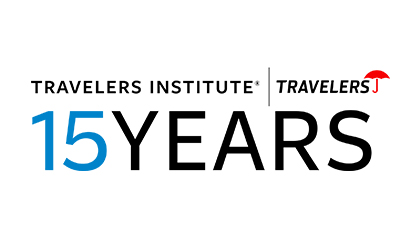

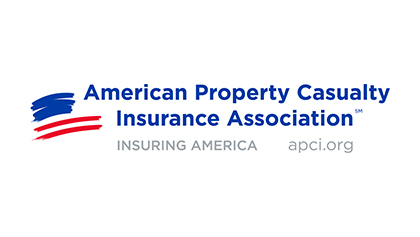
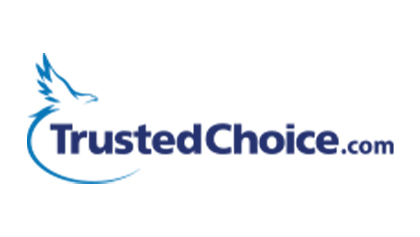
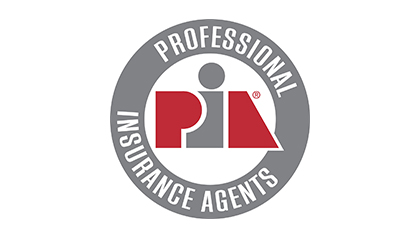


Related content
Crash and Learn LIVE Edition with the Insurance Institute of Highway Safety
The Travelers Institute brought our cameras to the Insurance Institute for Highway Safety for a heart-pounding, live crash test, with commentary and real-time reactions from IIHS’ safety experts.
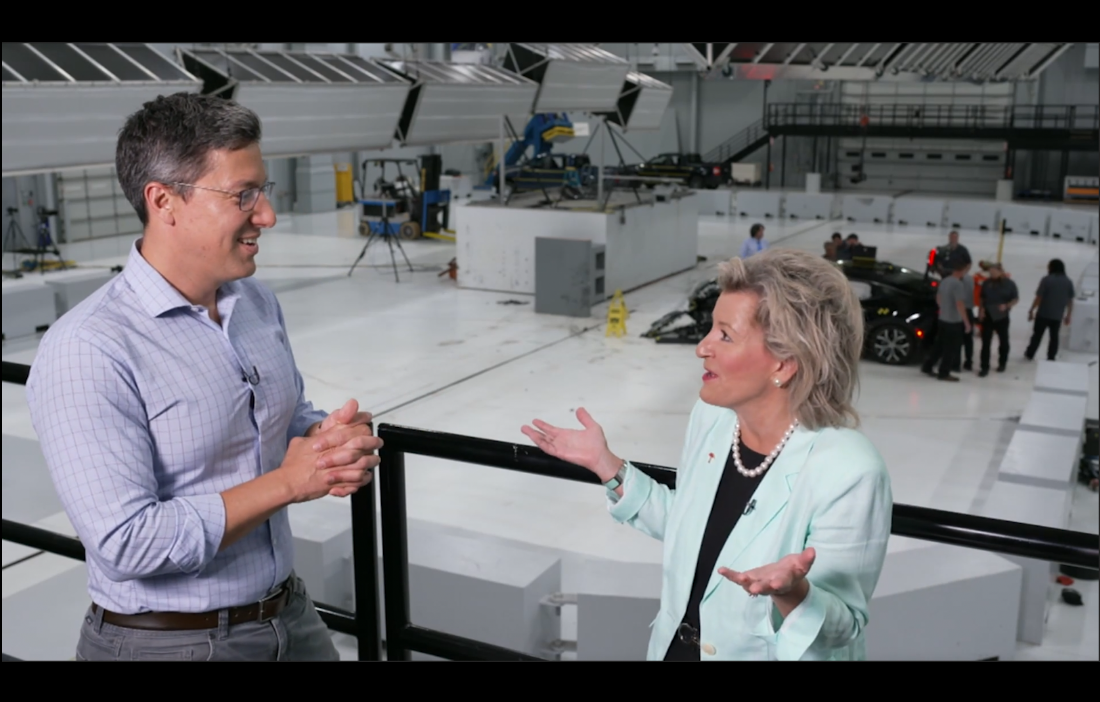
Storm Warning: Managing the Risk of Increasing Hurricane Catastrophes
In this webinar session, which included leading authorities in hurricane, storm surge and risk mitigation, we explored how to help mitigate the risk of hurricanes and storm surge.
